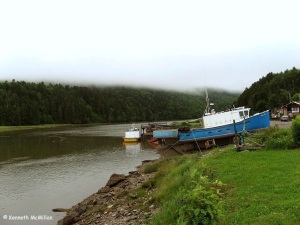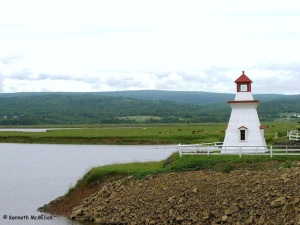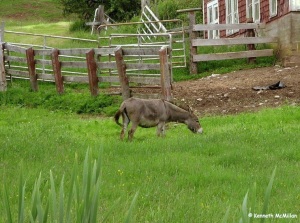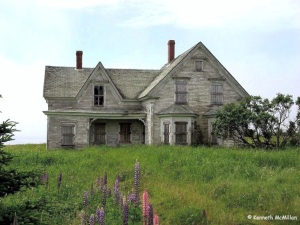(For those reading this for the first time, you might want to look at “About” before continuing)
Hi there,
Well, we made it to Nova Scotia after an interesting day yesterday though not quite what we expected.
We left Moncton and headed to Hopewell Cape to the south of Moncton. Hopewell Cape is known for its massive rock formations that are carved out of the coastal cliffs by the strong Fundy Tides and strong storm waves. We were hoping to either hike or kayak around them but arrived at the wrong time for both due to the tides. Unfortunately the fog also drifted in at the same time so we decided to explore elsewhere. We headed further down the coast to Cape Enrage which has a large bay and above it high cliffs and a lighthouse.
Cape Enrage
The bay is sandwiched by high shale cliffs at either end. The shale is layered like sheaves of paper, all very loose and slowly eroding into the bay. As a consequence, years of strong tidal action and waves have polished the beach stone into flat round rocks. Wave action has created a very steep beach at about 30º. On the high side of the beach the rocks are about the size of basketballs though flat. As you progress towards the water the stones get progressively smaller until they are about the size of peas, still flat and round. I had to convince the Lady not to load up her pockets and the car with stones. She thought that they would look great on her path at home!
From there we went to an attractive seaside town of Alma and watched the fishermen waiting for the tide to come in so that they could get their boats out of the harbour. Throughout this area the harbours go dry when the tide is out so the boats have to be tied up securely so they won’t tip. The tides will rise and fall 14 metres (45 feet) here, the equivalent of a five storey building, twice a day. It takes 6 hours and 13 minutes for the tide to go out and the same time coming in so a complete cycle takes 12 hours and 25 minutes.
After leaving Alma we backtracked a bit to a place called Harvey Bank. Harvey Bank is at the mouth of a one-time river that used to be wide enough to allow wooden ships to go upriver to the town of Riverside-Albert (2 kilometres). In the early 1800’s at the site of Harvey Bank, a Mr. Harvey started a wooden ship building business and built many of Canada’s wooden trading ships. His shipyard was very successful until the advent of steel ships. Acadian farmers were living in the area and they had slowly been building dikes and reclaiming the land from the sea and tide. When the shipyard eventually closed the river was dammed and that dramatically changed the flow of the river, turning it almost creek-like.
Again, throughout this area you can see acres and acres of land that had been reclaimed by the Acadians. The land that still remains as farmland seems marginal and mostly used for grazing. Over the many years, the dikes have deteriorated and the farmlands have reverted back to marshland. Conservation groups like Ducks Unlimited have been working to get these marshlands back to their healthy state in order to become wetland homes for waterfowl.
We then made our way back to Sackville, New Brunswick (after a brief period of the Man getting lost in Moncton) and stayed on the edge of the 15 hectare Tantramar/Sackville Marshlands. The town of Sackville was first laid out in 1762-63 and once again the Man and Lady were drooling over the beautiful old buildings. I can tell you, it is NOT pleasant riding in a hot muggy car with 2 drooling humans. They keep trying to use me as a wipe up rag!
Joggins, Nova Scotia
Today we made our way into Nova Scotia. The Man & Lady are planning to stay on the coast as much as possible no matter how small the road. Again the weather wasn’t too cooperative this morning with showers and some fog. The first stop was Joggins. The claim to fame for Joggins is the discovery in 1851 of a very rich fossil bed. The discovery was made by Sir Charles Lyell (a friend of Darwin) and Sir William Dawson, a famous Canadian geologist.
We parked on top of a small bank and walked down about 30 steps to the beach. All along the beach eroded sedimentary cliffs line the shoreline. The strong tides are constantly breaking the rock apart revealing coal seams and fossilized plants and animals. The beach is littered with broken rock which the Man and Lady picked through while I tried eating the seaweed – YUCK. It seems that seaweed, in particular dulse, is a favourite of the locals. You can buy bags of dulse in most stores right along side the potato chips. The Lady tried some and said that although quite salty, she liked it.
The hunt for fossils wasn’t too successful though the Lady may have found a little plant fossil. The two of them seemed to have fun pretending they were archaeologists while I decided that I will definitely stay away from seafood. From there we drove west along Chignecto Bay to Apple River then south to Advocate Harbour for lunch. Advocate is one of the oldest villages in Atlantic Canada being settled by the Acadians who again reclaimed many hectares surrounding the town using dykes.
From there we headed up a very rough, steep dirt road to the top of Cape d’Or which was supposed to have a spectacular view but once again the fog moved in and so the Man took pictures of white fluffy clouds which I liked a lot cause they looked like me. Unfortunately he didn’t keep any of the pictures.
Late this afternoon we arrived in a very picturesque town of Parrsboro which is considered one of the hottest fossil spots in North America. In 1984, Eldon George was seeking shelter under a rock outcropping when he noticed a shallow pool of water. In the bottom he found 28 perfect footprints of the world’s smallest dinosaur. In 1986, a biologist and a geologist discovered more than 100,000 pieces of fossilized bones from various species.
Tonight we had dinner at a restaurant overlooking the harbour. Inside the very large breakwater was all dry with the tide still going out so we may take a look tomorrow afternoon to see how it looks at high tide.
We’re also hoping to go to a provincial park called Five Island Park which is supposed to have some dramatic scenery. Hopefully the fog won’t be a problem!
Til later,
Miss Ewe




















